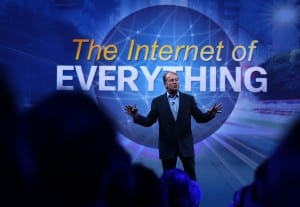Cisco Live 2014: The Journey to IoE, Cloud, and Services
Jim Lundy

During the Cisco Live event held in San Francisco, May 18th to 22nd, John Chambers delivered a positive message to the audience regarding Cisco’s strategy and roadmap. The key takeaways are where Cisco will be focusing efforts. This was the 25th Cisco Live conference with around 25,000 in attendance and more online.
The event kicked off with a very upbeat John Chambers, who even danced to Bobby Brown’s “My Prerogative” in his opening keynote. While it was a sight, I believe it was important for Chambers to present an upbeat and forward-looking Cisco to the audience.
Cisco and the Internet of Everything
Chambers focused on the Internet of Everything (IoE) as a driving force for Cisco and that is also itself driven by FastIT. We do believe change is a constant and that companies who don’t react to a changing marketplace will yield a competitive advantage, as things are moving at the speed of a connected world. In fact, an interesting data point that Chambers even notes is that only 24% of the Fortune 500 companies remain on that list from 25 years ago. This era that is about connectedness and digital business transformation will leave many organizations in the dust that refuse to transform business operations.
It’s this connectivity of people, objects, and data that is behind both the IoE and Internet of Things (IoT) concept that precedes it. When objects can present themselves digitally, it brings on a new way to connect things, but also yields more data from multiple places that will need higher levels of security and analytics to help manage it.
Move to a Services Model and New Cloud Strategy
Another takeaway was describing Cisco’s move to more of a services led model. This is not new positioning for Cisco. They have been saying this for years. In fact, John Chambers boldly stated in 2012 that Cisco will be a software and services company. This is a switch from the hardware-centric mentality of Cisco. Organizations are outsourcing networking to cloud service providers. Cisco has to look at expanding in other areas.
So, Cisco responds with software and services and a vision for the Internet of Things. In this connected world of mobile and cloud computing, Cisco’s InterCloud strategy will enable a world of many clouds and allow customers to build hybrid clouds and extend their data centers to public clouds as needed. The InterCloud will be a global network of Cisco partner clouds based on its application-centric infrastructure (ACI).
In this however, Cisco will find themselves being an arms merchant to cloud services providers, while providing cloud services of their own such as WebEx. This will be challenging, as it will bring some level of competition with their cloud service provider partners. This is a position we find Microsoft in as well with their partners.
Albeit, the InterCloud strategy promises cloud collaboration opportunities with a global network of partners of all sizes. We believe this brings Cisco into an interesting competitive situation with Google and Microsoft in the cloud.
As part of its services push, Cisco will also be growing its professional services business. A major challenge will be how Cisco will mobilize its channel to get on board with its services vision.
Cisco Video Collaboration Endpoints
Another highlight from Cisco Live 2014 was the new product announcements of the DX80 and DX70 desktop video collaboration tools. With all the talk of their services architecture and Internet of Everything, Cisco unveils two new hardware endpoints for video. Cisco’s last foray with desktop hardware, Cius, failed and was eventually pulled.
There is industry skepticism as to what will be different this time. We believe Cisco will have to focus messaging around the better video and audio quality of these devices as it fits to specific enterprise use cases. Cisco will also need to turn its technology-focused messaging to business-focused messaging.
On the Cisco Live stage, there was too much talk about architectures and technology specs, which we believe is missing the mark with the new business collaboration buyer. The new buyers are more business-focused and are concerned about business outcomes in regards to collaboration technology. So, Cisco will need to address the business buyer persona.

Have a Comment on this?